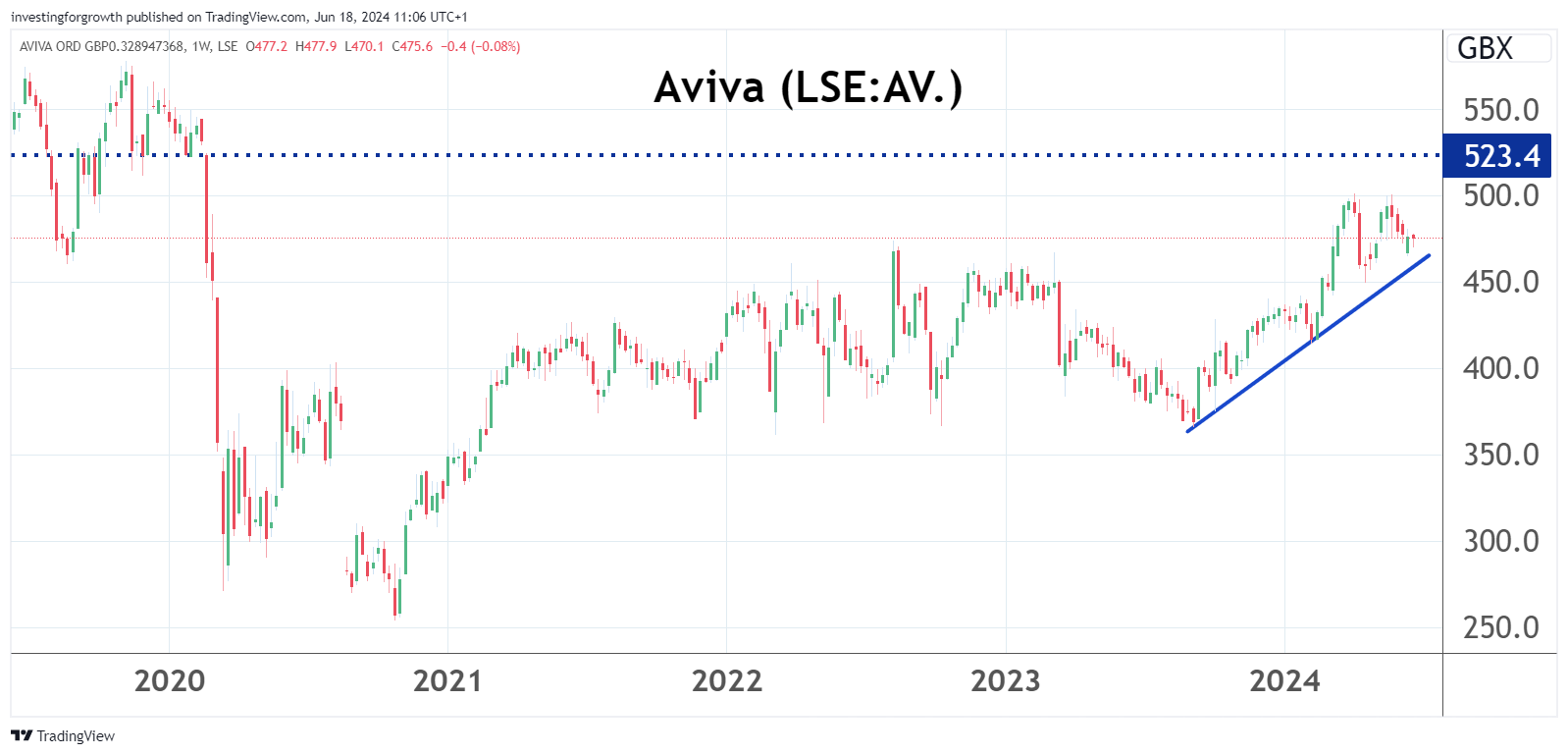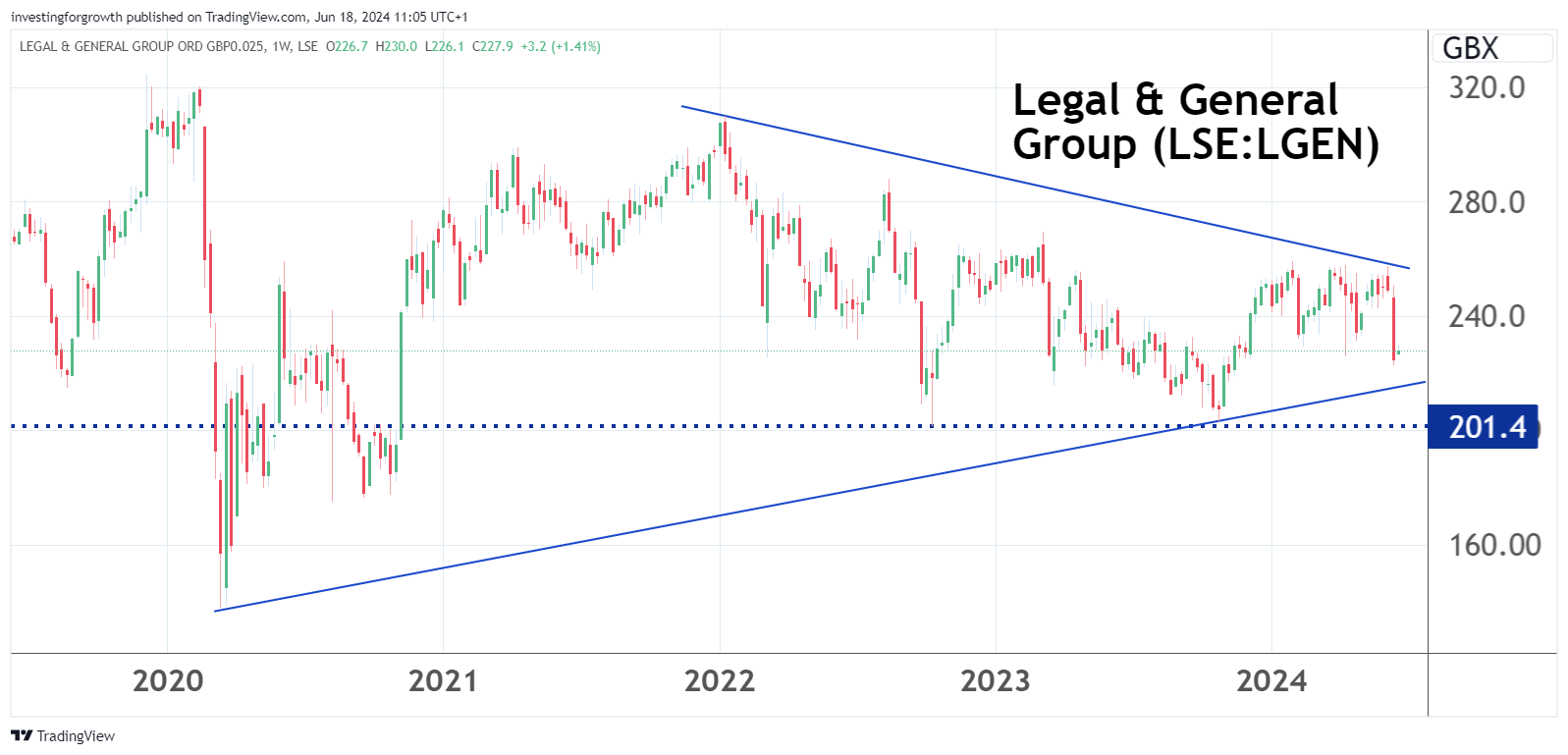Stockwatch: this 9% dividend yield may not be available for long
This FTSE 100 stock is a favourite among income investors and, while it may not be primed for exciting growth, analyst Edmond Jackson believes the current yield is excessive for the risks.
18th June 2024 11:11
by Edmond Jackson from interactive investor

What should we make of a down-dip in Legal & General Group (LSE:LGEN) shares, despite an overall robust update last week? Does it present a chance to buy into a company that has grown its dividend annually since the 2008 crisis (excepting 2020 during Covid)?
Following my study of Aviva (LSE:AV.) a week ago, L&G is an interesting comparison - and also with M&G Ordinary Shares (LSE:MNG) – as a Holy Trinity of high-yielding stocks in insurance and investment management.
- Invest with ii: What is a Managed ISA? | Open a Managed ISA | Top UK Shares
Furthermore, they’re worth considering as part of the dynamics under way within UK financial and “value” stocks. From February to May, we saw banks such as Barclays (LSE:BARC), Lloyds Banking Group (LSE:LLOY) and NatWest Group (LSE:NWG) re-rate sharply, since when (as I understand from discussion boards) it appears a significant number of investors tried to anticipate asset managers being next to move up – although that has so far proved elusive.
Only Aviva has followed the banks higher, I believe due to a new chief executive since 2021 selling off international interests to slim down the group to UK, Ireland and Canada, and also returning cash to shareholders. Such actions were attuned to what the market wanted, given they were proposed anyway by Cevian, Europe’s largest activist investor which became Aviva’s second-largest shareholder.
So, with Aviva there has been positive change in the underlying story to help trigger a de-risking of a circa 9% yield when its stock was down below 400p – hence for the price to rise.

Source: TradingView. Past performance is not a guide to future performance.
Legal & General, however, has yet to break out of downtrend since 2022:

Source: TradingView. Past performance is not a guide to future performance.
Moreover, at 227p, L&G’s stock remains very much within a sideways-volatile trend over the last decade between 190p and just over 300p.
2023 annual results conveyed mixed performance
The key bright spot in annual results was a proclaimed Solvency Two surplus cash generation stable at £1.8 billion, if easing 5% below £1.4 billion at the net level. Even so, the group cash flow statement shows net losses on investments impacting operational cash flow from £13 billion to £23.5 billion negatively. For context, dividend distributions cost less than £1.2 billion and the group anyway received£4.3 billion of dividends. Year-end cash fell 43% to £20.5 billion, hence it would appear to need a financial crisis to prompt a dividend cut.
In divisional operating terms, the main annuities’ retirement side saw 10% growth, helped by workplace pensions’ demand, while retail annuities were flat and there was a 19% decline on the smaller investment management side. Yet the proportions in a group context kept divisional operating profit flat.
- Stockwatch: Aviva shares remain a priority for income investors
- ii view: Aviva has something for income and growth investors
I tend to think a Labour government would be broadly supportive for strength in workplace pensions being maintained.
What impacted profit over 90% at the pre-tax level and by 40% post-tax was a near £1.6 billion total “investment variances” hit to L&G’s proprietary assets “driven by the unrealised mark-to-market impact of higher interest rates on asset valuations”.
This, however, ought significantly to be reversing given markets have in the last six months or so, priced assets in anticipation of rate cuts.
But it reminds us of and underlines a key dilemma with the big life and pensions insurer, how macro events affecting investment assets can make a big difference to these group’s reported numbers. I believe it is significantly why the stock market prices their equity generously for yield, as part-compensation for such risk.
Legal & General Group - financial summary
Year-end 31 Dec
| 2016 | 2017 | 2018 | 2019 | 2020 | 2021 | 2022 | 2023 | |
| Operating profit (£m) | 1,517 | 2,061 | 2,129 | 2,156 | 1,499 | 2,632 | 939 | 195 |
| Net profit (£m) | 1,258 | 1,891 | 1,827 | 1,834 | 1,607 | 2,050 | 783 | 457 |
| Reported EPS (p) | 19.6 | 26.3 | 29.9 | 30.4 | 21.0 | 32.6 | 11.2 | 1.7 |
| Normalised EPS (p) | 19.9 | 26.3 | 30.0 | 31.2 | 20.0 | 33.2 | 12.5 | 3.1 |
| Earnings per share growth (%) | 9.5 | 32.2 | 14.0 | 4.1 | -35.8 | 65.9 | -62.4 | -74.9 |
| Return on capital (%) | 0.3 | 0.4 | 0.4 | 0.4 | 0.3 | 0.5 | 0.2 | 0.0 |
| Operating cashflow/share (p) | 68.7 | 74.0 | -18.9 | -60 | 68.5 | -2.7 | 326 | -227 |
| Capex/share (p) | 0.8 | 3.9 | 6.7 | 1.5 | 2.6 | 3.3 | 3.0 | 3.8 |
| Free cashflow/share (p) | 67.9 | 70.1 | -25.6 | -61.8 | 65.9 | -6.0 | 323 | -231 |
| Dividend per share (p) | 14.4 | 15.4 | 16.4 | 17.6 | 17.6 | 18.5 | 19.4 | 20.3 |
| Covered by earnings (x) | 1.4 | 1.7 | 1.8 | 1.7 | 1.2 | 1.8 | 0.6 | 0.1 |
| Cash (£m) | 25,717 | 18,919 | 17,321 | 13,923 | 18,020 | 16,487 | 35,784 | 20,513 |
| Net debt (£m) | -22,302 | -14,978 | -12,393 | -8,496 | -12,131 | -11,299 | -30,212 | -14,505 |
| Net assets (£m) | 6,945 | 7,516 | 8,580 | 9,038 | 9,997 | 5,455 | 5,562 | 4,826 |
| Net assets/share (p) | 117 | 126 | 144 | 152 | 169 | 91.4 | 93.1 | 80.7 |
Source: historic company REFS and company accounts.
How generous should this yield be?
L&G’s outlook statement affirmed management’s expectation to generate £8-9 billion cash over 2020-24, the net aspect of such to exceed near £6 billion paid out as dividends. The total dividend rose 5% to 20.3p, implying a yield very close to 9% with the stock currently 227p.
There was a rather incongruous reference, however, to “the board’s intention to grow the dividend at 5% until 2024” - given we were already three months into it.
Then last week came news – by way of a Capital Markets event on strategy - of an effective de-basing of dividend growth to 2% annually from 2025 to 2027. This would not even match retail price inflation, assuming the Bank of England even achieves its target. Perhaps people should have read the March statement more cynically, yet its confirmation hit the stock nearly 8% initially, given many people hold L&G for income.
- Sign up to our free newsletter for share, fund and trust ideas, and the latest news and analysis
- ii view: dividend star British American Tobacco on track in 2024
Despite announcing a £200 million buyback programme “as a first step to increase returns”, the 2% growth was specified in per share terms, hence including the aspect of buyback (due to reducing shares in issue). Unless L&G’s communications side is inept, returns are being trimmed, hence equity was marked down and has recovered only modestly.
But one should not lose sight of how, at 227p, the stock yields over 9% as the pay-out edges up to around 21p in the next two years. Arguably riskier smoking stocks such as British American Tobacco (LSE:BATS) offer 10% at around 2,400p.
For how long is it likely to last?
If financial markets take the view that a strong-majority Starmer government will be reasonably positive for UK growth and improves Britain’s relations with the EU, pensions and asset management stocks like this could rise after the general election.
Like we saw with UK bank equities, high yields may be considered excessive – especially with the risk-free rate of return on cash likely to fall. It looks like a plethora of high-interest bank accounts – currently offering 5-6% with few if any conditions – are a flash in the pan.
In due course - and even if L&G recovers the upper level of trading in 2024 at 250p - a relatively dependable yield above 8% could be sought more keenly by investors than now.
- ii view: L&G strategy and share buyback disappoint
- Stockwatch: I’d buy this FTSE 250 share with 6% yield
My reading is that Labour will raise capital gains tax (CGT) on shares (its chief assurance is not to introduce CGT on your primary home), likely to prompt an aspect of (individual investors) re-prioritising towards income than capital growth.
Rigorous corporate review if nothing much radical
Relative to Aviva’s vigorous restructuring, L&G’s pitch comes across as the kind of updating necessary to remain competitive. In fairness, however, Aviva was overly sprawled abroad. A new CEO from 1 January proclaims belief in “strong foundations and excellent potential” given the need for better retirement provision amid ageing demographics.
He targets annual earnings per share growth in high single digits with an operating return on equity above 20%, although the 2023 results show they can still be impacted by macro conditions. Greater focus is to be achieved via a single asset management division for the group, with a revised capital allocation policy.
- Pensions case study: the final yards to retirement and beyond
- Getting to grips with new pension tax-free lump sum allowances
The institutional pension market is seen offering growth. Only 10% of £6.6 trillion equivalent defined benefit pension assets in the UK (where L&G is market leader), US, Canada and Netherlands, have so far transferred to insurers. Annual UK volumes are thus projected at around £45 billion over the next decade versus £25 billion a year since 2018.
The US and Canada are also seen offering growth, and partnering is being explored in the Netherlands. The institutional side is targeted with 5-7% annual growth in operating profit to 2028. Retail is tagged with a 6-8% annual increase in operating profit to 2028, focusing on a Workplace platform. For the asset management side there is an objective for £500-600 million operating profit by 2028.
While this does not amount to exciting growth, I believe it implies a 9% yield is excessive for the risks, so unless some kind of crisis beckons, then the stock favours upside – even if essentially maintaining its 10-year volatile-sideways trend. Buy.
Edmond Jackson is a freelance contributor and not a direct employee of interactive investor.
These articles are provided for information purposes only. Occasionally, an opinion about whether to buy or sell a specific investment may be provided by third parties. The content is not intended to be a personal recommendation to buy or sell any financial instrument or product, or to adopt any investment strategy as it is not provided based on an assessment of your investing knowledge and experience, your financial situation or your investment objectives. The value of your investments, and the income derived from them, may go down as well as up. You may not get back all the money that you invest. The investments referred to in this article may not be suitable for all investors, and if in doubt, an investor should seek advice from a qualified investment adviser.
Full performance can be found on the company or index summary page on the interactive investor website. Simply click on the company's or index name highlighted in the article.
Disclosure
We use a combination of fundamental and technical analysis in forming our view as to the valuation and prospects of an investment. Where relevant we have set out those particular matters we think are important in the above article, but further detail can be found here.
Please note that our article on this investment should not be considered to be a regular publication.
Details of all recommendations issued by ii during the previous 12-month period can be found here.
ii adheres to a strict code of conduct. Contributors may hold shares or have other interests in companies included in these portfolios, which could create a conflict of interests. Contributors intending to write about any financial instruments in which they have an interest are required to disclose such interest to ii and in the article itself. ii will at all times consider whether such interest impairs the objectivity of the recommendation.
In addition, individuals involved in the production of investment articles are subject to a personal account dealing restriction, which prevents them from placing a transaction in the specified instrument(s) for a period before and for five working days after such publication. This is to avoid personal interests conflicting with the interests of the recipients of those investment articles.